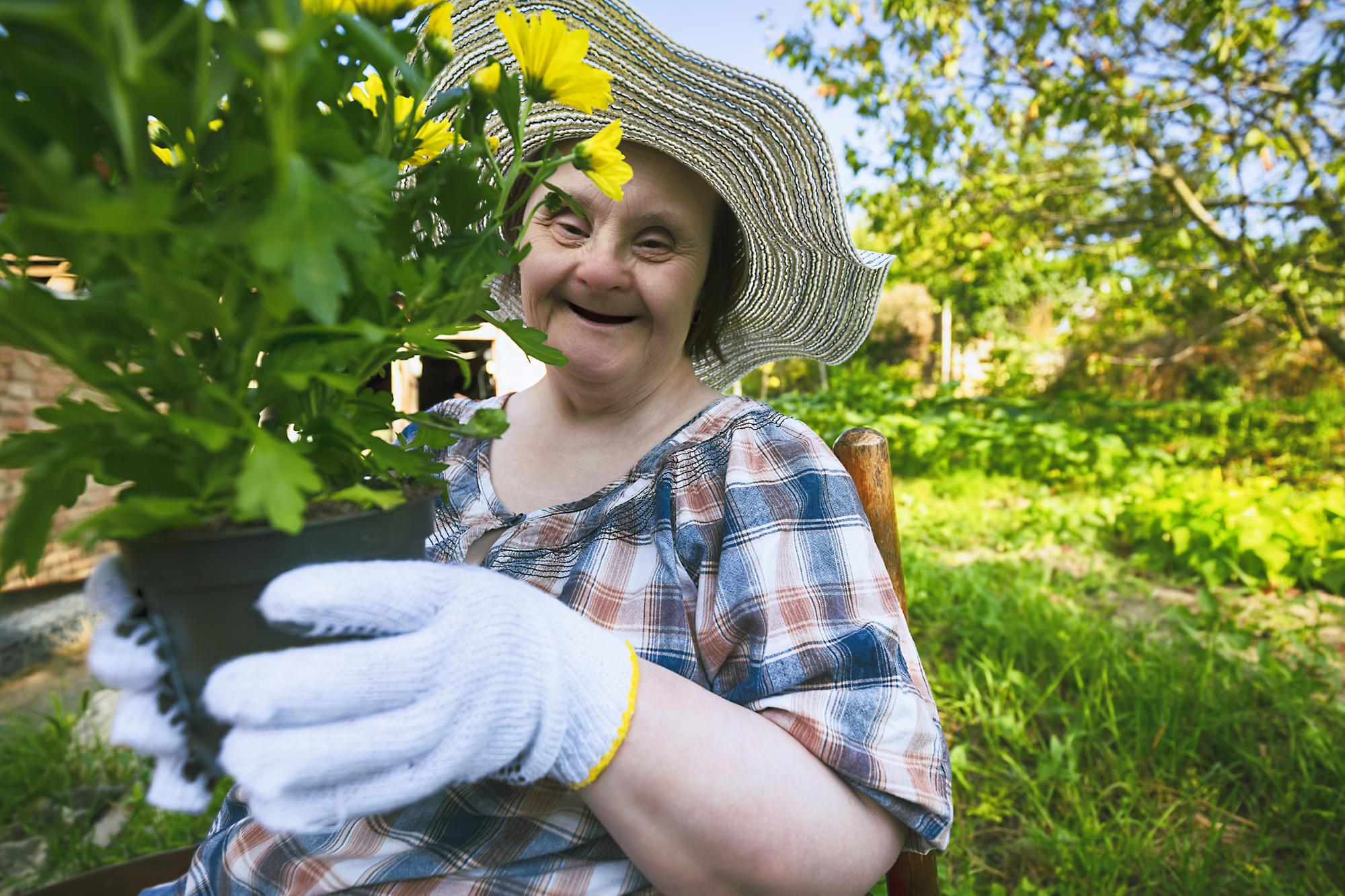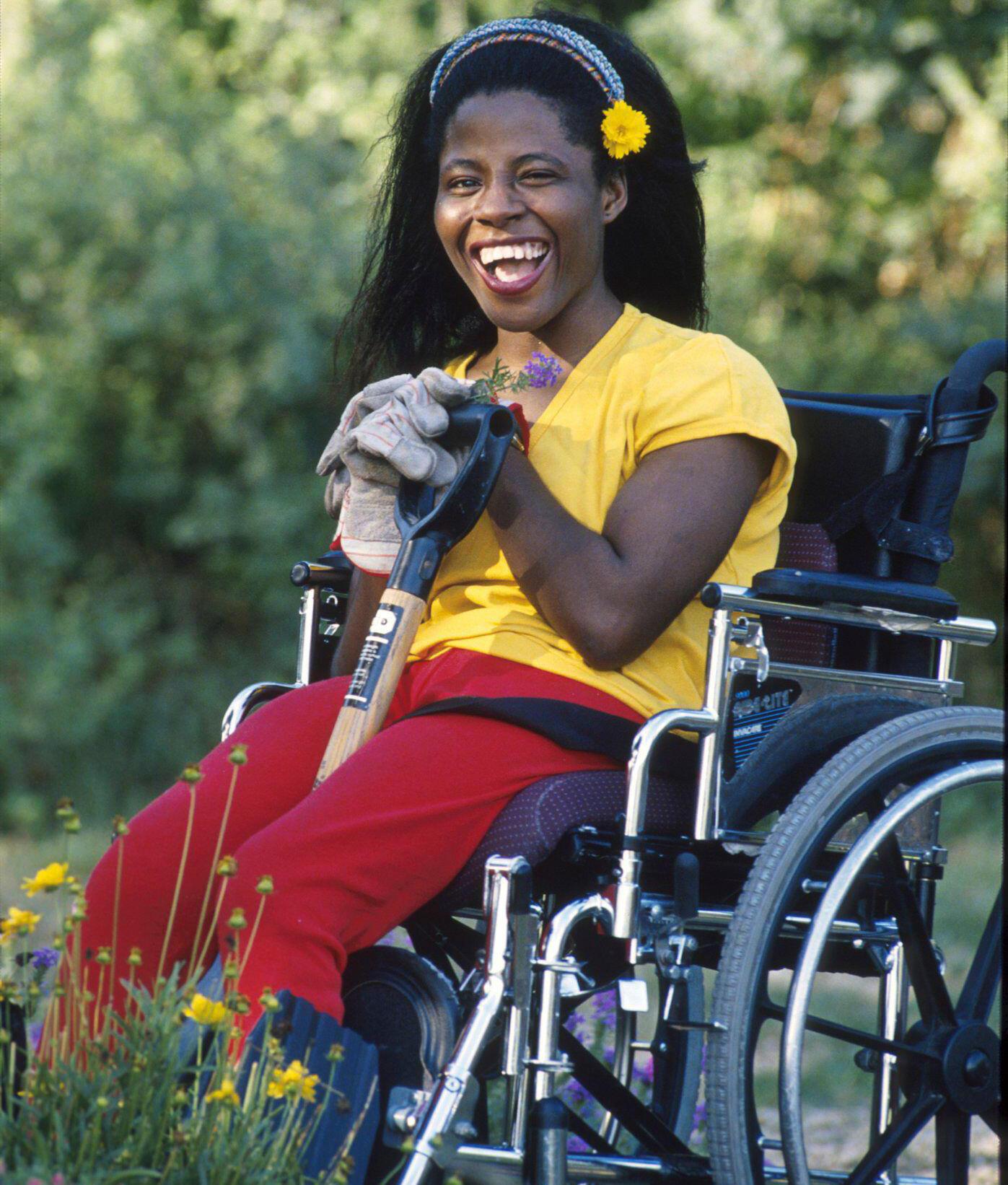Everyone benefits from gardens
It is important to provide gardening opportunities for everyone to reap the benefits of gardening:
- Enjoy fresh air, colors and textures.
- Experience the joy of caring for something living.
- Observe plants grow.
- Observe wildlife such as birds, bees and butterflies.
Exposure to nature and sunlight renews our spirit. Movement and activity help build strength. Friendships may be found in the garden. There are known physical, spiritual and mental health benefits of gardening and being among plants.
How to create accessible gardens
How do we create gardens that are inviting and accessible to all?
- Start with thinking about the vast range of human abilities. Consider the diverse needs and interests of gardeners and visitors to the garden.
- Recognize that differences in one’s abilities may be related to a specific disability that affects movement (for example, cerebral palsy, muscular dystrophy), sensory abilities (visual impairment, hard of hearing), communication and cognition. These disabilities can be lifelong or newly acquired.
- Recognize that differences in one’s abilities may be related to changes a person experiences with aging or overall health that can affect one’s energy level, stamina, balance, range of motion, strength or a combination of these things. If we live long enough, we will all experience some degree of disability.
Americans with Disabilities Act
Many public garden spaces need to comply with the Americans with Disabilities Act. For details see ADA Accessible Route and ADA Ramp (ADA Compliance Directory). Consult with a landscape architect if your project requires ADA compliance.
Universal design
Universal design is creating an environment that can be accessed, understood and used by all people, regardless of their age, ability or disability. Everyone benefits from a smooth garden path. Design gardens so people can move easily through the garden and enjoy the space rather than worrying about navigating an uneven pathway.
To create inclusive gardens, ensure the garden paths are smooth. Designing for a person with disabilities provides universal benefits for all users.
Accessible garden spaces
Garden spaces should be designed to allow people of all ages and abilities to enjoy and participate in the garden experience.
Bring the garden to you
- Pot up plants and bring them on your deck or patio.
- Make it easy to water and care for your favorite plants so you can enjoy them more. Self-watering pots lessen the gardener’s workload and keep the plant consistently hydrated without daily effort.
- Placing pots in key places close to your home allows you to enjoy the fragrances and colors throughout the day without expending a lot of energy.
Vertical gardens
- Vertical gardens can be built on supporting structures, fences, or trellises to bring the plants up to eye level.
- This method creates easy-to-access and beautiful garden spaces.
- Growing plants vertically allows you to keep the floor as open as possible for ease of movement and increased safety. Use drip irrigation to water plants in vertical gardens.
Raised beds
- Raised beds are a great choice for almost anyone interested in vegetable gardening for convenience and increased productivity.
- Gardeners who use walking aides or wheelchairs or have difficulty kneeling or bending find raised beds beneficial.
- The raised bed dimensions should allow the gardener to easily access plants in the bed center. The width should be no more than 4 feet for adults and 3 feet for children.
- Easy access raised beds are 3 feet or more in height. A standing gardener does not have to stoop over; the work surface is no lower than the fingertips.
- Raised beds for seated gardeners who use wheelchairs tend to be about 2 feet high or elevated to the height of 3 feet on legs. Provide enough room underneath the bed for the mobility aid to roll.
Navigate with ease
- Smooth, level pathways offer better accessibility for people who use mobility devices such as wheelchairs or scooters.
- Well-maintained, hard-paved surfaces such as concrete and asphalt reliably ensure accessibility for all. Compacted gravel can also be used for pathways (see How to Make a Gravel Surface Wheelchair Accessible).
- Wood and patio blocks can provide a firm and stable surface. Pathways should be 3–4 feet wide to accommodate both wheelchairs and wheelbarrows.
- Make sure pathways are clutter-free. Don’t leave garden hoses or tools lying in the pathway. These can be a trip hazard or block access.
Rest with ease
- Every garden needs a bench.
- Gardens are for admiring. What better place to admire the magnificence of plants growing than from a bench strategically placed in the shade?
- Having a place to rest in-between garden tasks will encourage you to be in the garden for longer periods.
Adaptive tools and equipment
Adaptive gardening tools can simplify gardening tasks and help people with physical challenges and disabilities be more productive and enjoy their time in the garden. A variety of tools are available commercially, and many standard tools can be modified to meet individual needs.
- Easy grip tools often feature padding to make tools easier to hold. Foam tubing, bicycle grips or tape can be added around tool handles to give a wide and easier grip.
- Ergonomic tools are designed for greater comfort and less stress on the body. Curved handles allow for better wrist position. Tools with an upright (pistol grip) handle are specially designed for people who experience hand and wrist pain when using standard gardening tools.
- Lightweight equipment and tools are easier to carry, and many gardeners find them easier to use. Children’s garden tools may offer good options for those who prefer smaller-sized trowels, rakes or cultivators.
- Long-handled tools or tools with handle extenders improve your leverage and prevent having to bend over too far. For example, a long weed grabber allows the gardener to pull weeds more easily from an upright position.
- Keep your tools in good condition. Use a tool sharpener for your pruners so every cut you make is efficient and takes less effort.
- Mark tools with bright colors to support gardeners with low vision. Wrap the handle of garden tools with bright duct tape or paint with light colors so that they are easy to find.
- Avoid carrying heavy watering cans or heavy hoses. Make irrigation easy with automatic watering systems or use lightweight coiled hoses, which do not get tangled.
- Protect your knees. Use inexpensive foam pads, knee pads or kneeling benches with handles when you need to get close to your plants.
- Use an upside-down 5-gallon bucket or a portable bench seat to work from a seated position in the garden to ease your back and knees.
- Have a potting bench or table nearby to work in a standing position for some tasks.
- Make locating and carrying garden tools and supplies easy with a sturdy bucket or basket with a handle. Wear a carpenter’s apron with deep pockets to carry small tools and seed packets.
- Smaller wheelbarrows are available with two wheels. They distribute the weight better, are more stable and are easier to handle.
Plant selection
Choose plants that match the gardener’s abilities and interests. Easy-care gardens allow the participation of a more diverse group of gardeners. Gardens that require less work are more accessible to a greater number of people and give the gardener more time and energy to experience the joy of being in the garden.
Here are some plant-selection ideas for creating a low-maintenance garden:
- Look for plants that don’t require as much watering, pruning, staking or deadheading.
- Select healthy plants and varieties that are disease- and pest-resistant.
- Plant perennials or shrubs for low-maintenance areas.
- Plant annual plants such as flowers and vegetables where they can be regularly maintained.
- Choose plants that are well-suited to the location so that they will thrive with limited maintenance.
- Consider low-maintenance groundcovers as alternatives to lawns. Groundcovers can also suppress the growth of weeds in planting beds.
Sensory plants
People enjoy plants that offer sensory experiences.
A sensory garden includes a collection of plants that appeal to one or more of our senses: sight, smell, sound, touch and taste.
Sensory plants allow visitors to enjoy various sensory experiences, which can engage a wide group of people to enjoy the garden.
For example, people with sensory differences affecting sight or hearing can become more engaged in the garden when attention is paid to texture, smell, color contrast and sound.
A person with limited motor skills may not be able to perform heavy garden work but can enjoy the tastes and textures that different plants offer.
Examples of plants that engage the senses include:
- Touch — wooly lamb’s ear, succulents, Irish moss, snapdragons
- Taste — basil, strawberries, chives, rosemary, nasturtium
- Smell — jasmine, lavender, mint, hyacinth
- Color — daffodils, rainbow chard, pansies, cornflower
- Sound — plants that rustle when the wind blows, such as ornamental grasses and corn or the seed pods of false indigo, which rattle when dry
The gardener
It’s not just the plants and tools that must be cared for and maintained.
Gardening tasks require physical activity. Understanding and appreciating that different people have different physical abilities is important.
For most of us, our abilities also change as we age. We must take care of ourselves in a sustainable way so we can access the gardening experience throughout our lifetimes.
Here are some tips that will help all plant enthusiasts stay healthy and engaged in their favorite garden activities:
- Like any other physical activity, stretch and warm up before gardening.
- Change gardening tasks every 10–20 minutes. Changing activities helps keep things interesting and reduces fatigue. Alternate the task and the part of your body that you are using. For example, switch from pruning to raking.
- Pay attention to your posture. Stand or sit up straight and change positions periodically.
- Pay attention to how you carry things. If you are walking, lift with your legs and engage your core. Keep items close to your body as you move with them. For mobility aids, place items in the basket or bag. Don’t overload your mobility aid.
- Take frequent breaks to rejuvenate. Allow yourself to appreciate your gardening accomplishments and the splendor surrounding you.
Gardening is for everyone. People of all ages and abilities can enjoy the rewards of caring for plants and experience the pleasures of being in nature.
Accessible outreach materials for public gardens
Consider the communication needs of the gardeners and visitors. Some people may understand information better with visuals and graphics rather than by reading text. A person who is blind will appreciate signage that includes braille. Or use assistive technology for mobile devices to interpret garden signage.
Accessible gardening resources
- Community Gardens Accessibility Guide (PDF) Grass Roots Gardens of WNY
- Creating a Sensory Garden (South Dakota State University Extension)
- Guide to the ADA Accessibility Standards for Ground Surfaces (U.S. Access Board)
- Raised Bed Gardening (OSU Extension Service)
- Universal Design (University of California Agriculture and Natural Resources)











